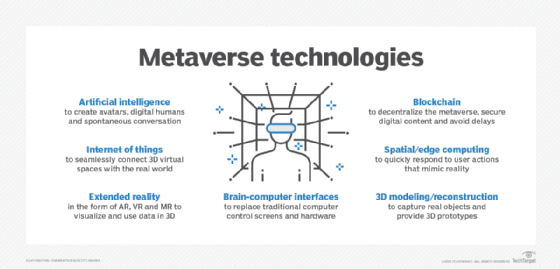7 top technologies for metaverse development
Several advanced technologies in various stages of maturity have been powering everyday business processes. How will they one day transform the 3D virtual world into reality?
The metaverse is a nascent, evolving space whose definition can vary widely depending on whom you ask. At this point in time, the challenge is to compile a comprehensive and dependable list of technologies that will help the metaverse flourish over the next decade. We managed to do just that.
"We look at metaverses as not a specific group of technologies per se, because they are made up of multiple technologies," observed Marty Resnick, vice president analyst at Gartner. Instead, "we see them as tech themes.'' Spatial computing, digital humans, virtual spaces, shared experiences, gaming and tokenized assets are among these themes, Resnick said, and they encompass a range of technologies that will help empower the metaverse's development.
Similarly, Forrester Research characterizes these types of technologies as "enablers of 3D development environments" that can do sophisticated modeling, according to J.P. Gownder, vice president and principal analyst. As a result, he explained, organizations will require professionals skilled in 3D modeling and familiar with Unity and Unreal game engines. Other required skills will depend on what's being programmed -- for example, IoT skill sets for digital twins. "Most companies won't have these skills right now," Gownder noted, "and will need to work with outside parties or recruit talent."
Metaverse-enabling technologies can range from gaming engines to digital twins to extended reality that are converging to address real-world problems in new ways, added Jason Warnke, senior managing director and global digital experience lead at IT consultancy Accenture. "A burgeoning company may completely build out its own metaverse before ever making an actual move in the real world,'' Warnke conjectured. "It might construct a digital twin that lays out exactly how a factory would look before ever laying a brick. Before taking a single dollar or swiping a credit card, they may have outlined its own NFT system."
"The Corporate Hitchhiker's Guide to the Metaverse," by Boston Consulting Group (BCG), designates the following three categories of technologies that define the metaverse:
- Metaverse worlds (M-worlds).
- Augmented reality (AR), virtual reality (VR) and mixed reality (MR).
- Web3 and virtual assets.
M-worlds are immersive applications that offer companies new ways to reach audiences, notably Generation Z users. M-worlds can run on mobile devices, as well as PCs and AR/VR headsets. Web3 is in its early stages but, according to the BCG guide's authors, "is already powering a vibrant virtual asset economy that includes cryptocurrencies, NFTs [non-fungible tokens] and smart contracts." The consulting firm expects Web3 and traditional financial transactions to coexist in the foreseeable future. In fact, the authors see "much of the value of the metaverse may ultimately lie not in consumer but in business applications." Those applications might include virtual meetings, training sessions, new product designs and providing virtual tours of homes to prospective customers.

Based on expert opinions and extensive research, we've narrowed our list to seven of the most frequently mentioned technologies that will help power the metaverse and its development.
1. Artificial intelligence
AI plays a core role in developing bots and chatbots, and brings intelligence to computer vision in the real world. But, according to BCG, only 10% of companies report significant AI benefits from their deployments. AI's processing capabilities could create metaverse avatars, enhance the characteristics of digital humans to make them more lifelike, and be applied to nonplayer characters that converse with players in gaming environments.
2. Internet of things
The Blockchain Council refers to IoT as "an important pillar of the metaverse infrastructure." The metaverse and IoT integrated together can, for example, "unlock new opportunities for industrial domain, individual needs and social requirements," the council reported. IoT would allow virtual spaces to seamlessly access and interact with the real world, while the metaverse would provide the 3D user interface for the IoT device cluster, resulting in what the council calls "a user-centered IoT and metaverse experience." In a factory where the digital twin of every machine has sensors, for instance, sensor data can be used to explore environments and provide feedback, Gownder said.
3. Extended reality
AR, VR and MR technologies will transform the way businesses visualize and use data by shifting from 2D to 3D for more realistic experiences and digital displays that better synchronize with head movements, according to BCG. When AR glasses become more mainstream, computer vision will help people understand the environment and locate the right information. Extended reality (XR) is already being used, for example, in Microsoft's HoloLens, allowing users to experience 3D holographic images as though they're a part of their environment.
4. Brain-computer interfaces
Although the World Economic Forum (WEF) includes brain-computer interfaces on its list of technologies that will shape the metaverse, Gownder believes BCIs are "science fiction for now … Find me someone using BCI for business." WEF acknowledges that BCI is "perhaps the most far-reaching vision for the metaverse" as the technology aims to replace traditional control screens and physical hardware. Still, the forum noted that BCI and XR combined "position themselves as the next computing platforms in their own right."
5. 3D modeling and reconstruction
3D reconstruction captures the shape and appearance of real objects and will make the metaverse a reality. The technology includes tools such as 3D modeling to provide a three-dimensional framework and prototype of a specific process or product. For perspective, the global 3D reconstruction technology market is expected to double over the next several years to more than $2 billion by 2030, according to a SkyQuest Technology Consulting report.
6. Spatial and edge computing
Spatial computing combines AR, VR and MR to interact with the real world, and edge computing can provide the quick response time to user actions that mimic reality and keep users immersed in the metaverse. Any kind of spatial technology -- including computer vision -- is very relevant to metaverses, Gownder said, adding "being able to place an avatar, collaboration, it's all about the spatial dimension.''
7. Blockchain
Blockchain isn't "super relative to employees or enterprise metaverses today,'' Gownder surmised. Yet, discussions center on how the technology can be used to secure digital content and data in the metaverse. Blockchain could a play role in decentralizing the metaverse to avoid delays or single points of failure.
What's on the horizon
Deloitte defines digital humans as avatars -- AI-powered human-like virtual beings -- that can engage in human conversation by interpreting a customer's language and return not only the facts the customer needs, but also the appropriate nonverbal response.
Gartner's Resnick pointed to a use case in which a company builds a virtual customer experience center for networking, socializing or transacting. "If you think of the scale of the metaverse," he conjectured, "I can't staff [it] 24 hours a day and I can't deal with a large number of folks who may come into that room. So, I can use digital humans to be that conversational AI or … non-player characters that can act as a representative of my organization." Companies can provide a presence, converse with customers and build trust. "I want to see a face of the organization as opposed to billboards," Resnick added. "It's one of the many use cases we see."
Gartner is also predicting that enterprises will likely focus on virtual spaces and shared experiences first. Probably the biggest area of investment in the next few years will be in what Gartner calls intraverse technologies. "An intraverse," Resnick explained, "is essentially how we look at building internal virtual environments for the use of employee communication, collaboration, onboarding and training. It's another way of saying we're creating our own virtual office." By 2027, Gartner predicted, fully virtual workspaces will reimagine the office experience and account for 30% of the investment growth by enterprises in metaverse technologies.
Esther Shein is a freelance writer and editor whose work has appeared in several online and print publications. Previously she was the editor in chief of Datamation.com. She was also a senior writer at eWeek (formerly PC Week) magazine and worked at The Associated Press and for community newspapers. She holds a B.S. in broadcast journalism from Boston University. She is a member of the Internet Press Guild.







